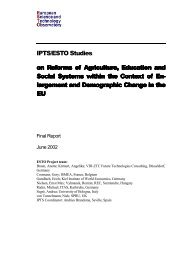Achievements of Europe's regional policy 2004-2009 - Et2050.eu
Achievements of Europe's regional policy 2004-2009 - Et2050.eu
Achievements of Europe's regional policy 2004-2009 - Et2050.eu
Create successful ePaper yourself
Turn your PDF publications into a flip-book with our unique Google optimized e-Paper software.
<strong>2004</strong>-<strong>2009</strong> Report<br />
2. Integrating the new Member States<br />
In the period since <strong>2004</strong>, perhaps the greatest challenge has been to ensure a smooth and<br />
successful expansion <strong>of</strong> the Union with the entry <strong>of</strong> twelve new Member States. A key<br />
priority has been to help the new Member States and their regions to obtain the full benefit <strong>of</strong><br />
the opportunities <strong>of</strong> <strong>Europe's</strong> single market, by being able to compete successfully. A<br />
particular need has been to extend <strong>Europe's</strong> communication networks, mobilising, in<br />
particular, the resources <strong>of</strong> European <strong>regional</strong> <strong>policy</strong>. Several <strong>of</strong> the key features <strong>of</strong> the<br />
contribution <strong>of</strong> the <strong>policy</strong> to making this happen are set out below. However, it will be a longterm<br />
task requiring many years <strong>of</strong> investment in infrastructure, in innovation and business<br />
development, and in upgrading human resources.<br />
i) Contributing major resource allocations: 'phasing-in' <strong>2004</strong>-2006 and 2007-2013<br />
• As a first major contribution, resources for investment <strong>of</strong> some € 22 billion were set<br />
aside to finance <strong>regional</strong> <strong>policy</strong> for the period <strong>2004</strong>-2006 in the countries which joined<br />
the Union in <strong>2004</strong>. This amount - corresponding to around € 100 per capita per year –<br />
allowed these countries to gradually get accustomed with the management <strong>of</strong> the<br />
<strong>policy</strong>. A learning process in terms <strong>of</strong> programming, project identification, financial<br />
management, monitoring and evaluation was set in motion in view <strong>of</strong> the new<br />
programming period 2007-2013.<br />
• In December 2005, almost € 160 billion was allocated within the new financial<br />
perspectives for <strong>regional</strong> development programmes in the new Member States<br />
(including Romania and Bulgaria) for the period 2007-2013 - equivalent to € 260 per<br />
capita (more than 5 times the average support in the old Member States). This<br />
represented an almost three-fold increase compared to the previous period and a<br />
budgetary contribution equivalent to around 3.2% <strong>of</strong> the GDP <strong>of</strong> these economies.<br />
• New Member States have rapidly and successfully developed their capacity to spend<br />
these resources effectively and efficiently. With support from the European<br />
Commission, these Member States have put in place partnerships, multi-annual and<br />
strategic planning, and systems for monitoring, evaluation and audit. Though the first<br />
results <strong>of</strong> the ex-post evaluation <strong>of</strong> the period suggest some room for further<br />
improvement, the achievements <strong>of</strong> the first short programming period are nothing<br />
short <strong>of</strong> impressive.<br />
ii) Developing administrative capacity<br />
• Economic growth not only depends on investment, but also on the availability <strong>of</strong> a<br />
reliable administrative system and a transparent legal framework. The Commission<br />
has succeeded in ensuring that the new delivery system for EU <strong>regional</strong> <strong>policy</strong> for<br />
2007-2013 is based on best practice in this regard, including supporting specific<br />
programmes for administrative reform and the development <strong>of</strong> institutional capacities.<br />
• Similarly, the availability <strong>of</strong> resources is one thing, but the capacity to use those<br />
resources by designing good programmes and preparing and realising good projects, is<br />
another. The evidence suggests that the new Member States had, with the help <strong>of</strong> the<br />
Commission, been able to make good use <strong>of</strong> the opportunity to develop absorption<br />
capacity in the period <strong>2004</strong>-2006 and, by 2007, the <strong>policy</strong> had even set a record in<br />
terms <strong>of</strong> levels <strong>of</strong> resources for investment transferred. There is now a considerable<br />
similarity in absorption rates across all Member States.<br />
15







